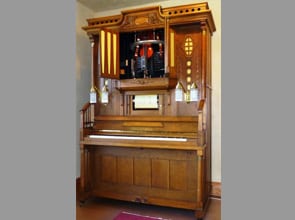
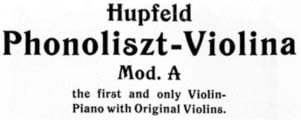
NOW: Complete Catalog of All Original Phonoliszt-Violina Rolls Click Here
Hupfeld Phonoliszt-Violina
Rick Crandall
The following article includes text excerpted from works by Q. David Bowers and Art Reblitz listed in the Bibliography.
During the period 1895 to 1935 music was spread geographically through the use of automatic music players controlled mainly with pneumatics. Air pressure and vacuum conducted through a maze of tubing allowed for astonishingly responsive actions needed to actuate a piano action (as with player pianos), organ pipes (imitating string and wind instruments), percussion (drums, xylophone, triangle, etc.) and eventually the most difficult of all – plucking a banjo and bowing real violins. Control was from a punched paper roll that traveled over a metal “tracker bar” that enabled sensing the holes in the roll as they passed over the holes in the tracker bar.
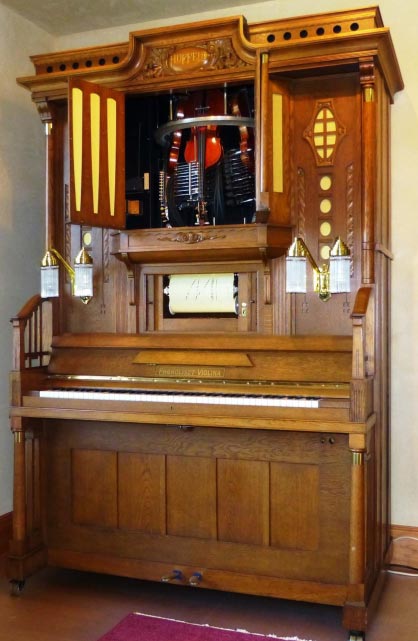
Automatic music machines were important to the music scene not only for their technological cleverness and eye-catching appeal, but they did a good enough job musically to enable the spread of a popular or classical tune as a standard, as opposed to individual performances by musical troupes. They also enabled an economic means for many more establishments to have on-site music – restaurants, bars and even houses of ill-repute.
In the late 1920s with the advent of electrical devices and sound amplification, the jukebox and radio took over and these machines, quite large physically, were destroyed, with small numbers surviving. Automatic musical instrument makers used organ pipes voiced to sound like a violin for their basic sound or solo voice in many different instruments. The best violin pipes sounded very realistic, but only a few people were inspired to create mechanism to play a real violin automatically with expression. This ultimate music machine would not only sound realistic, but would also have outstanding visual appeal.
Hupfeld, the world’s largest maker of automatic musical instruments in its day, began working on a mechanical violin player around 1900. By 1908, Hupfeld marketed the Phonoliszt-Violina, an instrument combining three real violins with a Phonoliszt expression piano.
“Phonoliszt” means “Sounds of Liszt.” Franz Liszt (1811-1886) was born in Hungary and became known as the world’s greatest pianist. He lived in Germany for years. His daughter, Cosima, married the renowned German composer Richard Wagner, further endearing people to Liszt’s music
The Phonoliszt-Violina is perhaps the ultimate automatic music collectible today due to its rarity, its realistic performance with expression on the piano and the violins and its solo capabilities combined with its visual impact. Its New York City distributor described the Phonoliszt-Violina: “The self-playing Violina is provided with real violins operated by a bow and made of 1344 horse-hairs means the solution of a problem that has been vainly sought for centuries.”
In April, 1912 in a testimonial by noted violinist Efram Zimbalist: “Certainly the Phonoliszt-Violina is the eighth wonder and marvel of our time.”
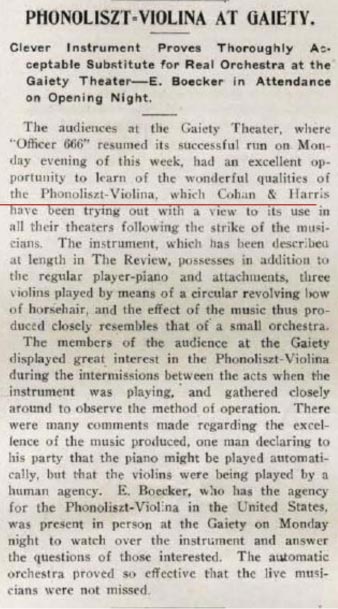 |
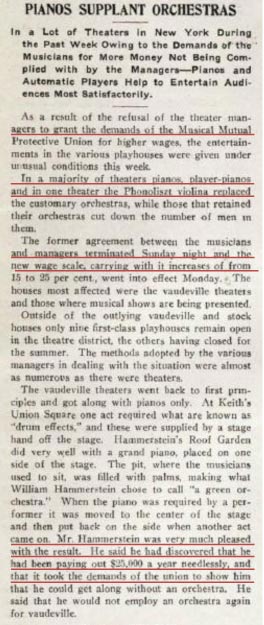 |
Above and below: Various 1912 “The Music Trade Review” articles
A boost was further given to the machine’s sales when the musicians union went on strike. Technology to the rescue! (note that the “Phonoliszt-Violina Orchestra” mentioned in the article below is just a nickname used by the publication for the Phonoliszt-Violina. They’re not referring to the later Violina Orchestra with drums, ranks of pipes, etc., introduced in the late 1920s.)
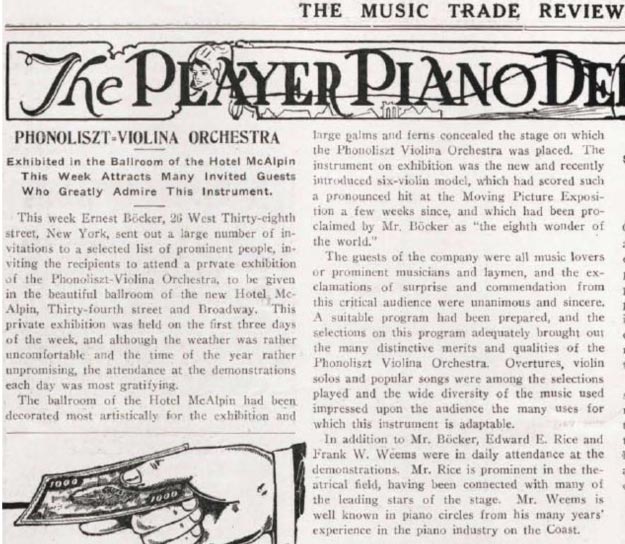
How the Phonoliszt-Violina Imitates a Human Violinist
A human violinist plays different notes by pressing the string against the violin fret-board to change its speaking length. Hupfeld’s mechanism has steel fingers with wood finger tips covered with thin rubber or leather pads, to simulate the texture of human fingers.
A real violin bow uses horsehair to play the strings. Hupfeld’s bow took the form of a large ring holding 1,344 strands of horsehair, tied around little steel pins. To simplify the complex problems of bowing, Hupfeld stood each violin upside down inside the circular bow. Only one of the four strings on each violin plays automatically. One, two or all three violins can play at once to provide solos, duets and occasionally, trios.
To keep the horsehair of an ordinary violin bow at the correct tension, a violinist tightens or loosens it with a threaded adjustment. When the violin is in storage, the violinist lowers the tension so it will not deform the shape of the wooden bow. The Hupfeld bow is metal, so there is no need to let down the tension between the performances. A clever spring-loaded mechanism keeps the horsehair tension the same regardless of humidity changes.
For good tone quality, a violinist occasionally applies rosin to the bow. In the Phonoliszt-Violina, the owner of the instrument applies rosin as needed by pushing a button. This causes a pneumatic to press a rosin cake against the bow. All violins go out of tune when the strings stretch and the humidity or temperature changes. The Phonoliszt-Violina has three tuning buttons. Each button plays one violin string and its corresponding piano note.
Hupfeld’s music roll editors understood how to arrange the expression control perforations in the rolls for human-like performance with realistic phrasing. The Phonoliszt-Violina is quite impressive when it plays a delicate pianissimo passage of staccato notes, or a quickly sweeping chromatic glissando. It is truly amazing when it plays an intricate phrase with accented notes superimposed on a slow, dramatic crescendo.
The roll library includes the usual high quality Hupfeld repertoire, from Handel, Mozart, and Beethoven to salon music, opera, and operetta selections. Hupfeld made popular music rolls for the Phonoliszt Violina as late as the sound-movie era of the early 1930’s.
It is not clear from available historical accounts whether the music was arranged by real musicians playing a device that marks a master roll from a recording instrument such as a piano keyboard or whether it’s musically competent professionals actually marking a master roll on a drafting table. If the latter, the process would take a musician who really understood the mechanism as there is much complication to the multiplexing of hole positions to get all the expression and other controls out of the tracker bar layout.
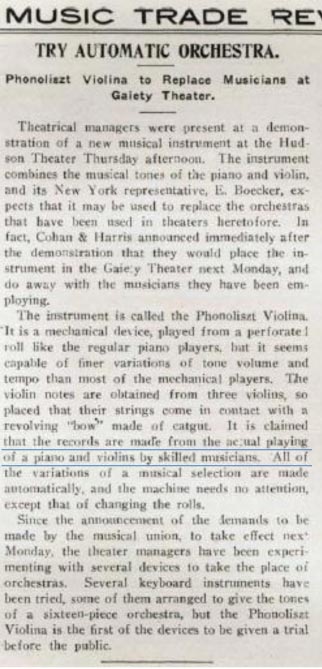
The article shown, if accurate, would seem to support the first theory that “the records are made from the actual playing of a piano and violins by skilled musicians.”
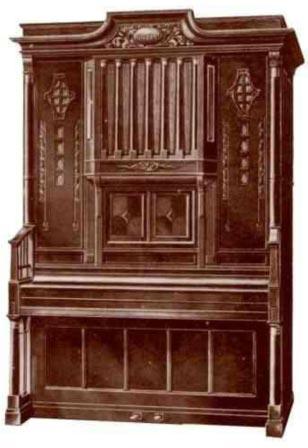
Circa 1912-14 catalogue illustration of Phonoliszt-Violina Model A
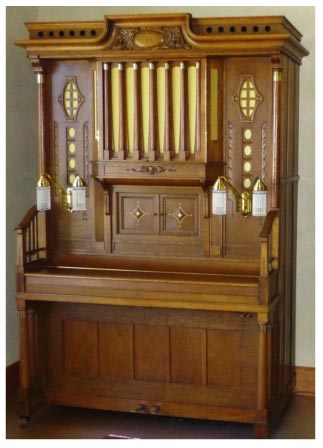
Crandall Model A machine made circa 1916
How Does the Phonoliszt-Violina Sound Realistic?
Each violin has a pneumatic that presses it against the bow. Control perforations in the roll vary the speed of the bow. When the bow turns faster, an adjustable cam mechanism also increases the pressure of the violin string against the bow. Three speed/pressure combinations produce soft, medium and loud play. Three rates of speed/pressure change provide faster or slower crescendos/decrescendos. The mechanism provides two types of accent: Heranbringer stark, causing the violin to move more quickly, and Betoner, which increases the bow speed and pressure. The music rolls use them separately and together for various accenting effects.
The vibrato mechanism creates a pleasing wavering in the pitch of the note being played. A human violinist accomplishes this effect by rocking his hand slightly against the string. In contrast, the Phonoliszt-Violina has a mechanism that pulls slightly on the end of each active violin string producing the same effect. A single hole in the roll activates the mechanism, producing one pulse of vibrato. With different hole spacing, the vibrato can be faster or slower, as needed for the music.
For an ethereal sound, a violinist attaches a mute to the bridge, damping the tone and loudness. In the Phonoliszt-Violina, a lever touches the bridge in a similar way when the music calls for a mute.
The piano expression is a simple but effective mechanism. A suction regulator provides three levels of loudness with gradual or sudden changes from one level to another. The piano hammer-rail is divided into bass and treble, with control of the bass half that allows treble piano solos.
A Hupfeld Model A Phonoliszt-Violina – Interior
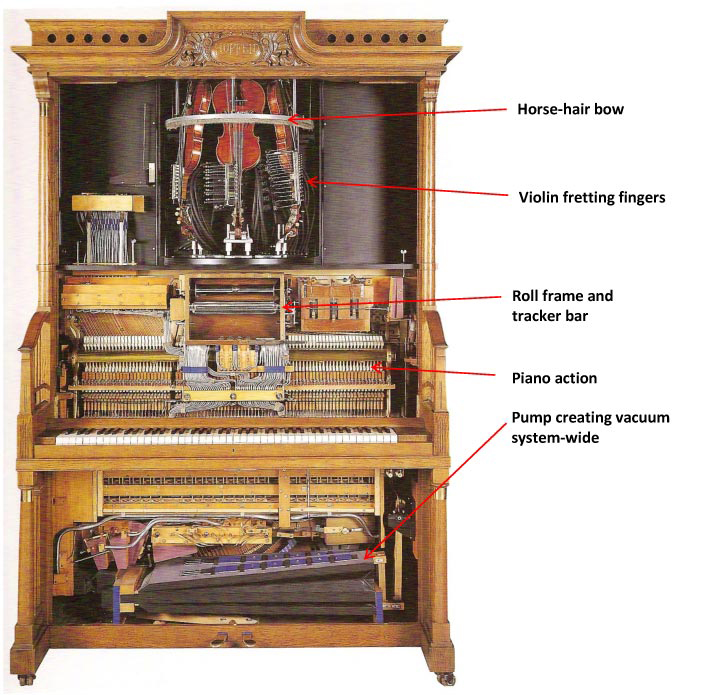
Phonoliszt-Violina Model A Stack # 3,500
7’6” x 5’ x 2’11” Wt. 1000 lbs.
Rick Crandall Collection
Aspen, Colorado
Restored by; Reblitz Restorations Colorado Springs, CO
Restorer Art Reblitz: “I had the violins repaired and polished by Eggen Violins in Denver who conserved the original finish. We cleaned and prepared all metal parts in my shop as we usually do instead of sending them to a plating shop for buffing, since the commercial buffing process often rounds off all the edges. I had them re-plated with electroless nickel, a little less shiny and consequently more original-looking than the typical modern plating job.
We installed a new pin-block, Renner hammers, and Renner action parts in the piano as necessary. The high-quality piano was made by Schimmel. There’s no marking on the piano plate, but the stack had the wording “Schimmel-Violina” written in pencil. The mechanical features are early, but not extremely early. It has the conventional spring-loaded tensioners for the bow hair, while the very early ones have manually-adjustable tighteners. The machine was restored from top to bottom, inside and out”
Close-Up of the Actual Playing Violins and Fingering Assemblies
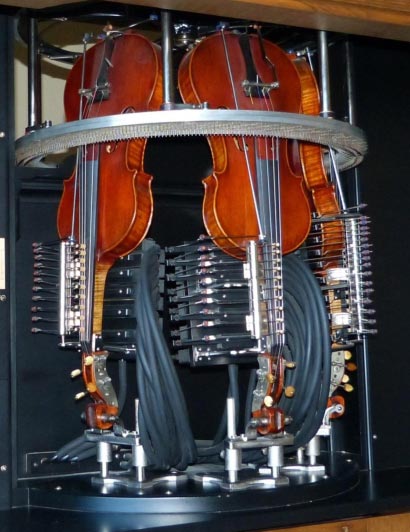
The “D” violin is on the left; the “A” violin at center; and the “E” violin at right. In the Phonoliszt-Violina the violins pivot forward into the circular bow (close up below). The complicated-looking mechanism with many black tubes leading away from it is the fingering mechanism, each finger controlled by a pneumatic taking instruction from the perforated roll. Note the visible lower portion of the circular horsehair bowing mechanism, which crosses each violin near its center.
The Bow
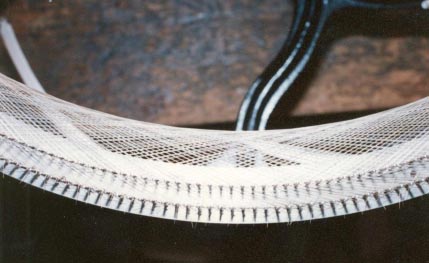
Reblitz: I used a bow re-hairing jig that a fine local machinist made for me. It counts pins from end to end of each hair, and ensures that each hair is at precisely the correct height on its pins. It takes me between five and six days to re-hair a bow.
Phonoliszt-Violina on Location
The Phonoliszt-Violina was ideal for restaurants, lounges, lobbies and other places where people congregated to relax. The music was rich but not overly loud and music was available for a broad range of tastes from classical to popular. Approximately 940 music rolls were created by Hupfeld over the years from approximately 1910 to 1932.
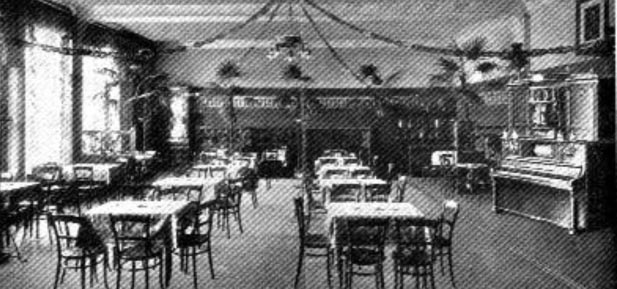
A Brief Look at the History of Hupfeld
Hupfeld grew to become the world’s largest distributor and manufacturer of “self-playing” automatic musical instruments, eventually producing a wide variety of disc, pinned-barrel and music-roll operated music machines in its own factories. Some of the automated orchestras crafted were spectacularly large and very complex devices. While other contemporary large and well known manufacturers of “automatics” could boast an employee count well into the hundreds, Hupfeld, in sharp contrast, had a contingent of employees numbering in the thousands.
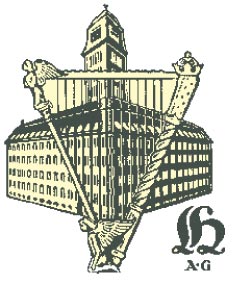
Sometime around 1880 to 1882 J.M. Grob, along with two partners, founded J.M. Grob & Company, opening a small “art shop” in Leipzig-Eutritzsch, Germany. The new company sold various mechanical musical instruments, such as disc music boxes and small hand-cranked organettes, but soon began manufacturing its own stable of mechanical instruments, which were marketed in the company’s shop alongside products from other companies. By 1886 an attachment for automatically playing pianos and organs, using paper tune-sheets, had been perfected. The ingenious Grob player action was licensed to other manufacturers for incorporation into their own products.
In time Grob & Company acquired the distributorship of many prominent musical instrument manufacturers in the Leipzig area, making Grob a well-known entity for both sales and mechanical music innovation. Then, in 1892, Ludwig Hupfeld took over the company, changing the name to Hupfeld Musikwerke.
To keep up with the demand for automatic music, the giant 1,000,000 sq. ft. Böhlitz-Ehrenberg factory was built in 1911, with its imposing tower (depicted in the logo above). By 1912 some 1200 employees manned the sparkling new factory, a number that climbed to over 2000 a few years later.
By 1925 automatic instrument sales had slumped to a mere trickle, the complicated and often temperamental music machines being replaced by the phonograph and the radio. In 1926, Hupfeld merged with Gebr. Zimmermann, a piano manufacturer.
Production of pneumatic automatic musical instruments stopped altogether about 1930. Music roll production ceased about 1934. After the war, what remained of the once huge factory reverted to music-related manufacturing. But this time it made ordinary pianos, continuing to this present day, under the new name of VEB Deutsche Piano Union. After the war any remaining traces of the glorious days of automatic instrument making were destroyed and forever erased from what remained of Hupfeld.
Although a small number of Hupfeld instruments were distributed in the U. S. by Ernst Böcker of New York City, for instance, few of these machines exist today.
Bibliography
Reblitz, Art, The Golden Age of Automatic Music Instruments, Woodsville, NH, Mechanical
Music Press, 2001
Order from: www.mechanicalmusicpress.com/reblitz
Bowers, Q. David, The Violin Playing Machines: Hupfeld Phonoliszt-Violina, Mills Violano-Virtuoso,
A Study and Appreciation, Automatic Musical Instrument Collectors’
Association (AMICA), 2012
Order from: www.amica.org/Live/Misc/Sales/Books/Violin-Playing/index.htm
Crandall, Rick, Phonoliszt-Violina Rollography, Aspen, CO, Self-published, 2012
Entire list of all rolls originally produced by Hupfeld for the Phonoliszt-Violina shown in two formats, one sorted by roll number and the other sorted by composer.
Accessible at: https://www.rickcrandall.net/pv-rollography/


